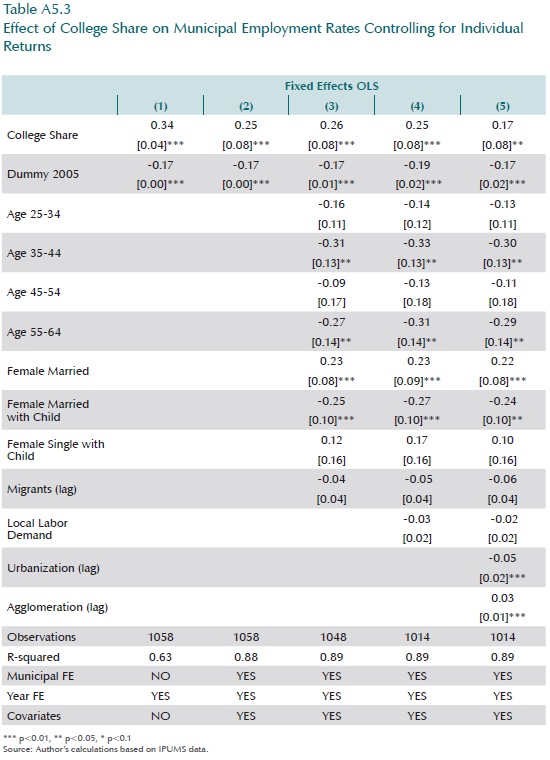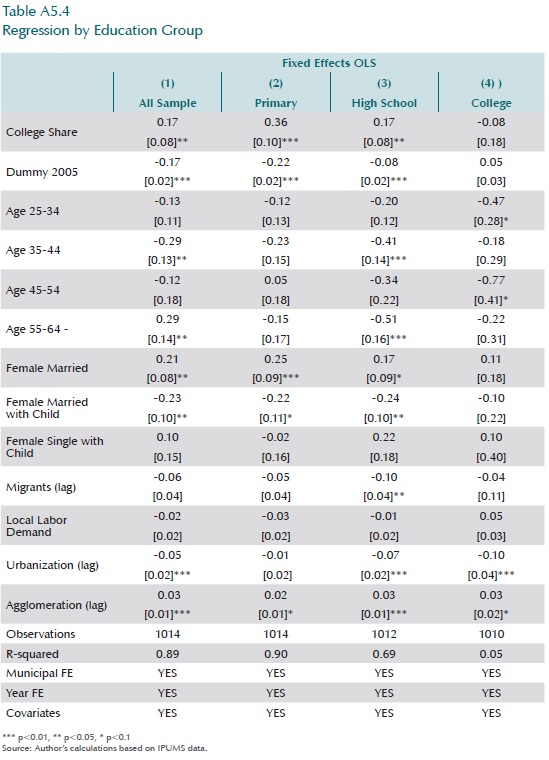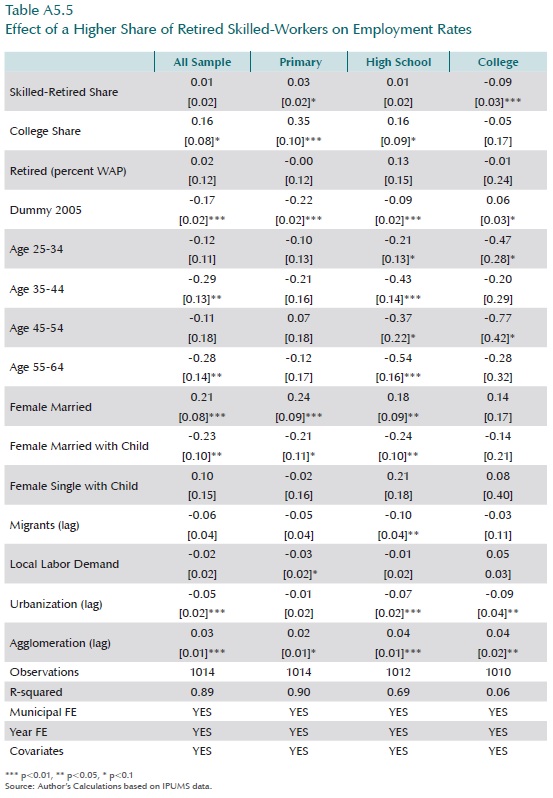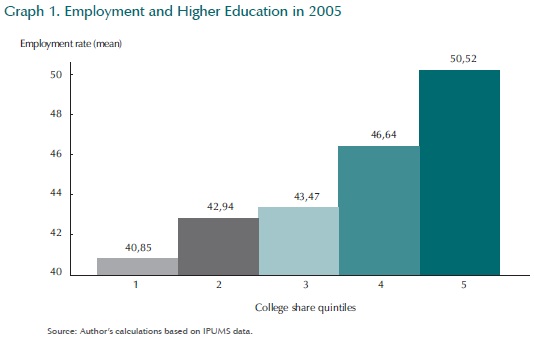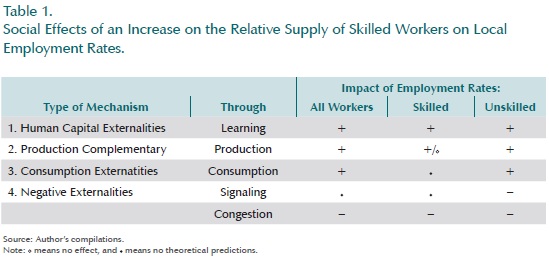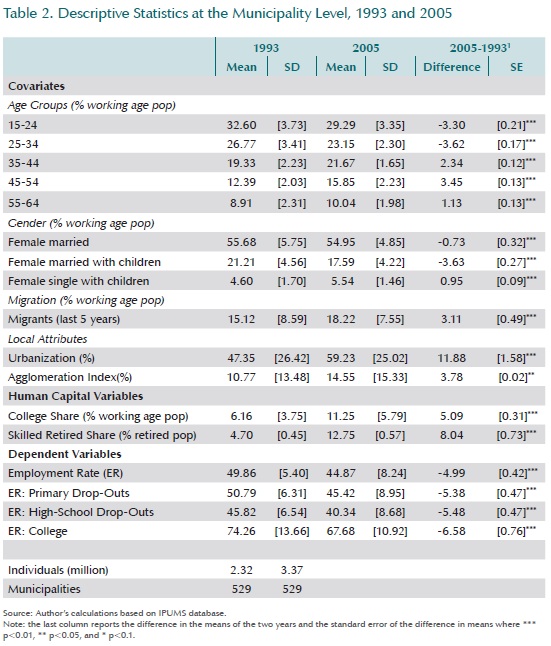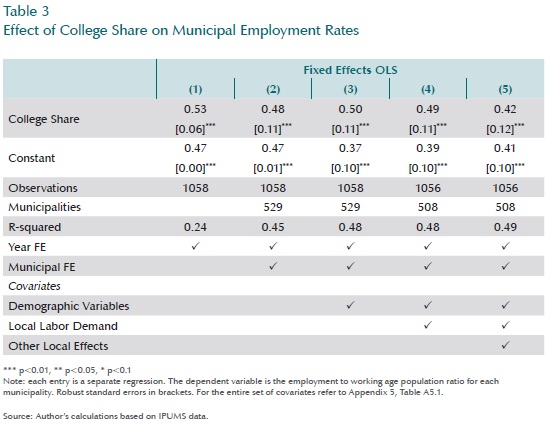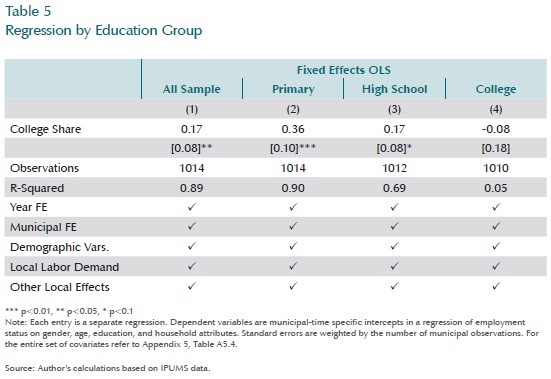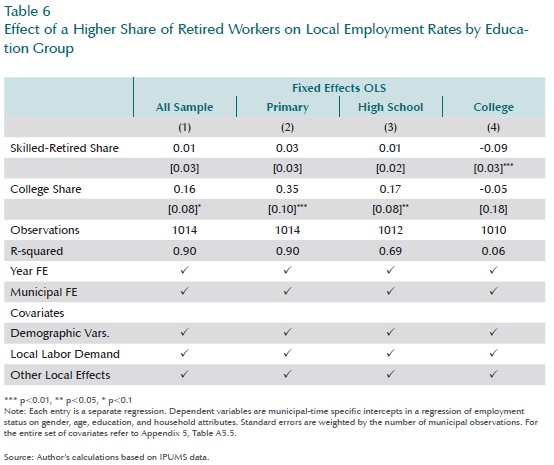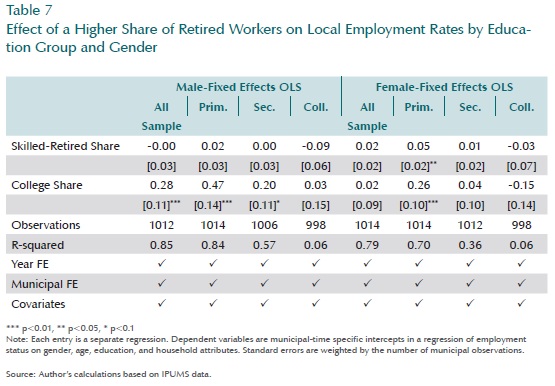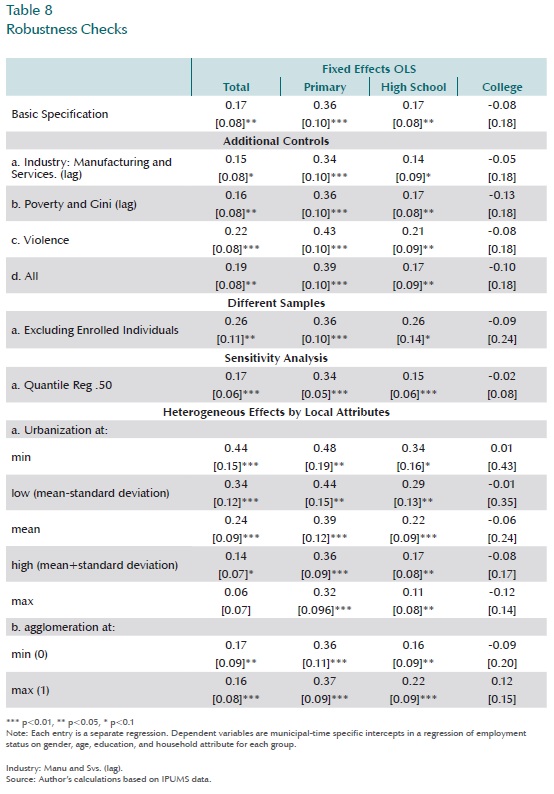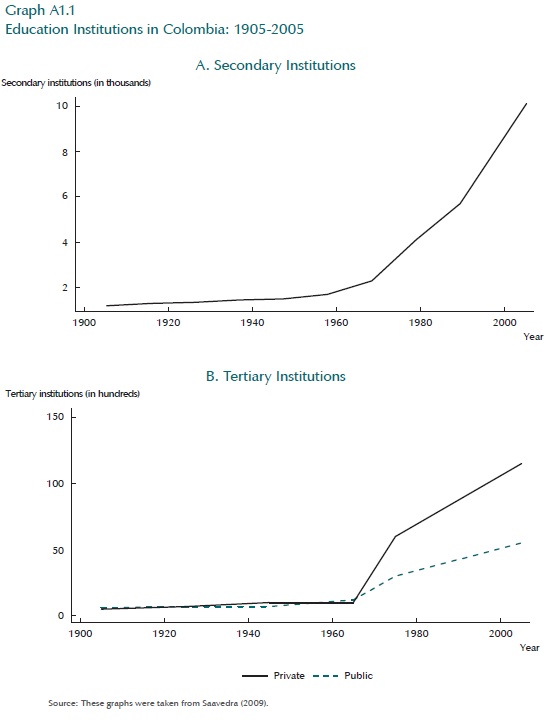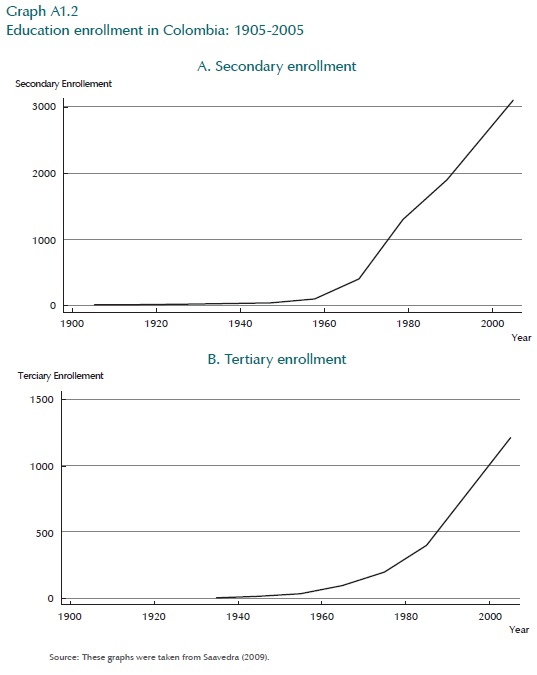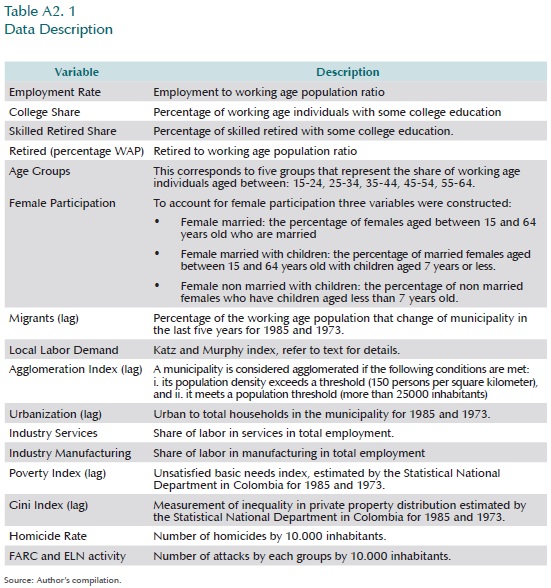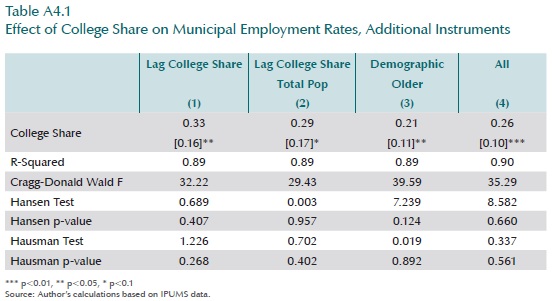Serviços Personalizados
Journal
Artigo
Indicadores
-
 Citado por SciELO
Citado por SciELO -
 Acessos
Acessos
Links relacionados
-
 Citado por Google
Citado por Google -
 Similares em
SciELO
Similares em
SciELO -
 Similares em Google
Similares em Google
Compartilhar
Ensayos sobre POLÍTICA ECONÓMICA
versão impressa ISSN 0120-4483
Ens. polit. econ. vol.31 no.spe70 Bogotá jan. 2013
ORIGINAL ARTICLE
The Employment Advantages of Skilled Urban Municipalities in Colombia
Las ventajas laborales de la aglomeración del capital humano en los muncipios colombianos
Ana María Díaz*
*Quisiera agradecer a Bart Cockx por sus comentarios, discusiones y guía. Este texto se benefició por los comentarios de Muriel Dejemeppe, Giordano Mion, Florian Mayneris, Sofía Pessao e Costa, Jean Francois Maystadt y Luis Eduardo Arango. Agradezco a los evaluadores anónimos por su positiva revisión. Sin embargo, todos los errores y omisiones que pueda tener el documento me corresponden. Me encuentro en deuda con la Oficina de Relaciones Internacionales de la Universidad Católica de Louvain, por su apoyo financiero. El autor es profesor asistente de la Facultad de Ciencias Económicas y Administrativas de la Pontificia Universidad Javeriana. Correo electrónico: a.diaze@javeriana.edu.co.
Documento recibido: 28 de junio de 2012; versión final aceptada: 18 de enero de 2013.
Abstract
This paper explores whether the agglomeration of human capital leads to social employment advantages in urban labor markets of Colombia. It compares employment opportunities in urban areas where the level of education differs while controlling for plausible confounders using census data for 1993 and 2005. Results show that employment opportunities are higher on average in skilled urban areas than in low-skilled urban areas. Recent literature has offered at least three explanations for this positive effect: human capital externalities, production complementarities, and consumption spillovers. To distinguish between them, I analyze the effect of an increase on the college share on the employment rate for different education groups. An increase in the supply of college graduates only affects the employment rates of primary and high-school dropouts. Human capital externalities and production complementarities explain the spatial employment differences in Colombia.
Key words: Local Labor Markets, Employment, Human Capital Externalities, Production Complementarities, Consumer Demand Spillovers, Signaling, Congestion.
JEL Classification: R23, J21, J24.
Resumen
Este trabajo analiza si la aglomeración de capital humano en los municipios de Colombia genera beneficios sociales en términos de mayores oportunidades laborales, por medio del empleo de datos censales de 1993 y 2005. Los resultados muestran que la tasa de empleo es, en promedio, más alta en los municipios con una mano de obra más calificada que en aquellos municipios con una mano de obra poco calificada. La literatura ofrece, al menos, tres explicaciones para este resultado: las externalidades de capital humano, las complementariedades de producción y las externalidades de consumo. Para distinguir entre estas, se analiza el efecto de un aumento en la oferta de mano de obra calificada en la tasa de empleo de individuos con diferentes niveles de educación. Los resultados sugieren que dicho aumento tiene un efecto positivo en la tasa de empleo de individuos que no terminaron la secundaria o la primaria.
Palabras clave: Mercados laborales locales, empleo, externalidades del capital humano, complementariedades de producción, externalidades de consumo, señalización, congestión.
Clasificación JEL: R23, J21, J24.
I. INTRODUCTION
Although economists for a long time have stressed that the spatial agglomeration of human capital creates benefits over and above the private returns accrued by individuals, it is only recently that economic literature reveals an increasing interest to quantify what happens to productivity, wages and employment when the human capital in a local area increases.1 This paper aims to contribute to the existing empirical literature by exploring whether the agglomeration of human capital leads to social employment advantages in Colombia.2 Social advantages are the external marginal benefits of an increase in the relative supply of skilled workers, net of individual private returns, in local labor markets. In other words, this article attempts to estimate the social effects of human capital agglomeration by comparing employment opportunities of individuals located in municipalities in which the level of education differs.
Social benefits from human capital agglomeration are usually regarded as the result of, either human capital externalities, production complementarities or consumption spillovers (Lucas, 1988; Duranton and Puga, 2003; Glaeser et al., 2004). Theories of human capital externalities emphasize the role of human capital to boost urban productivity (Lucas, 1988). A more productive workforce raises firms' incentives to entry, which in turn raises employment opportunities for both skilled and unskilled workers (Acemoglu, 1996). Moretti (2004b) and Ciccone and Peri (2008) posit that even in the absence of human capital spillovers, an increase in the supply of skilled workers might increase the demand for low skilled workers because they are imperfect substitutes in production (complementarity of tasks).3 Finally, the consumption hypothesis suggests that since skilled workers spend more than unskilled workers, for services like leisure and personal services, which are relatively low-skilled; an increase in the supply of skilled workers in a locality will increase the demand for low-skilled jobs (Manning, 2004).
These positive effects might be offset by negative externalities arising from signaling and congestion externalities (Moretti, 2004c; Saint-Paul, 1996a and b). Signaling models suggest that education instead of enhancing individual's productivity acts as a signaling device for unobservable ability. More specifically, firms infer ability from education, and students choose education level to signal their ability. If the level of workers' education increases locally, employers might simply raise their hiring standards. Hence, unskilled labor will be crowded out of the labor market into both unemployment and inactivity. Similarly, an increase in the relative supply of skilled labor might cause congestion externalities on other workers by reducing their job finding probability (Charlot et al., 2005; Charlot and Decreuse, 2005; Saint-Paul, 1996a and b).
In Colombia, municipal employment rates vary considerably according to municipal levels of educational attainment of its population. Graph 1 shows that in 2005 the average employment rate in the highest-educated municipalities (quintile 5) is ten percentage points higher than the average rate in the lowest-educated municipalities (quintile 1). This naturally raises the following questions: does human capital agglomeration spur local employment? More specifically: does human capital agglomeration creates employment benefits above personal private returns or are these benefits confined to those individuals who obtained it?
This article attempts to answer these questions using microdata from Colombia. Specifically, I use census data from 1993 and 2005 and exploit geographical variation in the fraction of individuals with some college education across Colombian municipalities to test whether the benefits of education are only reflected in employment opportunities of higher educated individuals, or if education carries social benefits (and social costs). Moreover, this study tries to identify which of the above mentioned explanations is the main underlying cause for the link between human capital and local employment rates. It also aims to contribute to the existing literature in a number of ways. First, this paper tries to shed some light on the social effects of higher education on a labor market outcome overlooked in the empirical literature: employment rates.4 Second, it uses different empirical strategies to identify the main underlying cause for the link between human capital and local employment rates. Another contribution is that it provides evidence for a developing country, whereas previous literature has almost exclusively focused on US and European cities and metropolitan areas.5
The empirical strategy follows the approach applied by Moretti (2004a) to explore social effects on wages in US cities and by Manning (2004) to evaluate the effect of physical proximity to skilled workers on the demand for low skilled workers also in US cities. It can be described in three broad steps. First, I evaluate whether the municipal distribution of human capital endowment plays a pivotal role in explaining municipal employment rates. Afterwards, I focus on municipal local labor markets and evaluate the effect of skilled workers by comparing the employment rate of otherwise similar municipalities with different shares of skilled workers in the working age population while controlling for individual education. Several strategies are taken into account to minimize the bias that might arise for unobserved municipal heterogeneity often manifested as omitted-variable bias.
Second, I try to identify the mechanism that is driving the results by estimating the effect of the rise on the share of skilled workers on employment rates of different education groups. Finally, to explore the importance of consumption externalities, I evaluate the effect of an increase in the share of skilled retired workers on the employment rates of different educational and gender groups.
The rest of the paper is divided into 5 additional sections. Section 2 provides a brief literature review; section 3 describes the data; section 4 provides the empirical strategy; section 5 presents and discusses the empirical results and section 6 concludes.
II. LITERATURE REVIEW
There is a broad consensus in the literature that higher educated workers experience a higher probability of being employed. Recent literature offers several explanations for this stylized fact. First, skilled workers are more efficient in acquiring and processing job search information; second, they possess skills often demanded in an economy with continued technological progress; third, they have more access to search networks and institutional support that allow them to relocate regionally, nationally, and even internationally, and fourth, both firms and skilled workers search more intensively to fill skilled vacancies. Such is not the case for unskilled workers in secondary markets (Mincer, 1991; Acemoglu, 1999; El- horst, 2003). Despite this general agreement on the ''private return'' to education, much less in known about what is the effect of an increase in the overall level of human capital on local employment rates.
I briefly review, in this section, what is known about the benefits of human capital, with particular emphasis on localized benefits. I explore the possible mechanism explaining why higher human capital in a locality affects employment prospectus above individual ''private returns''. This section is, then, divided into four main subsections. The first one explores the theories and the mechanism through which local human capital might positively affect local employment rates. The second reviews those theories claiming that human capital accumulation can negatively affect local employment rates. The third subsection summarizes all the mechanisms and provides their empirical implications. The last subsection reviews empirical research as it relates to these theoretical expectations.
A. POSITIVE EFFECTS
1. Human Capital Externalities
A large theoretical literature in both urban economics and macroeconomics has argued that aggregate human capital has a positive effect on productivity over and above its private effect, which makes human capital spillovers relevant factors in explaining the economic growth of cities, regions and countries (Marshall, 1895; Lucas, 1988). Workers in localities with high human capital benefit from increased productivity to a greater extent than the individual returns to human capital would account for (Acemoglu, 1996). In general, three different types of externalities have been identified in the literature: 1) technological externalities, 2) pecuniary externalities, and 3) nonmarket externalities.6
Technological human capital externalities arise if educated workers increase the productivity of other workers through processes of informal learning, without being compensated. Lucas (1988) posits that physical proximity with educated workers may lead to better sharing of ideas, faster innovation or faster technology adoption. More recent models argue that individuals augment their human capital through pairwise meetings with more skilled neighbors in which they exchange ideas (Jovanovic and Rob, 1989; Glaeser, 1999; Glaeser and Mare, 2001). Thus, an increase in the stock of skilled individuals increases local productivity through human capital externalities and direct technological spillovers. This positive productivity shock might induce employment expansion since firms will respond by creating vacancies in the locality (Glaeser et al., 1992; Glaeser, 1999 and Henderson, 1997).
Under this theory an increase in the relative supply of skilled workers affects both skilled and unskilled workers, since firms will respond by creating more vacancies as the productivity in the locality increases.7
Pecuniary human capital externalities arise from market interactions and not from direct effects on production possibilities. Acemoglu (1996) shows that, in a labor market where it is costly for firms and workers to find each other, pecuniary externalities arise through the interaction of workers' and firms' decisions under imperfect information. Workers invest in human capital, which depends on the probability of being employed. Firms decide whether to create a job or not before knowing who they will finally employ. Moreover, firms open their vacancies as a function of the average expected benefits. A more educated labor force will increase the expected profits per vacancy opened inducing job creation in that area. At the same time, the rise in average human capital increases worker's probability of finding a job. Since there are search frictions, some workers that did not raise their level of education will also benefit.
Non-market oriented externalities might also arise on improved opportunities for learning, sharing and matching.8 Heuermann (2009) argues that higher levels of education improve average matching by improving the flow of information on job opportunities.9 He posits that job related information diffuses more rapidly and more effectively with higher localized levels of human capital.10 Given that the flow of information is strongly localized, regions with higher shares of educated workers might exhibit an improved flow of job related information and, therefore, better local labor outcomes. The difference between technological externalities and this type of mechanism is that the former refers to knowledge spillovers as being of pure technological nature (i.e., it provides information about the production process), whereas the latter refers to knowledge spillovers about vacancies, jobs and careers.
Overall, an increase in the relative supply of skilled workers in a local market generates external benefits for other workers, since firms will respond by creating more vacancies as the productivity in the locality increases. Also because the profits that the firms expect are higher or as a consequence of the improved flow of job related information through access to better job referral networks and lower information costs. In this case, both skilled and unskilled benefit from the increase in the relative supply of skilled workers.
2. Production Complementarities
Another possible explanation for a positive effect of local human capital on employment rates is a complementary relationship between different skills in the production process. According to a standard demand-and-supply mechanism an increase in the supply of skilled workers may affect employment opportunities of unskilled workers depending on the degree of substitutability or complementarity between them. Specifically, when the two types of workers are gross substitutes an increase in the supply of skilled workers reduces the demand for the other. When these inputs are gross complements, an increase in the supply of skilled workers creates added demand for the other.
Ample evidence supports the idea that workers with different educational attainment levels are complements in production (see, for example, Katz and Murphy, 1992). In particular, under imperfect substitution, a higher share of college graduates in the workforce should be associated with an increased demand for unskilled workers. For example, an increase of specialist doctors in a city augments the demand for less skilled occupations such as receptionist and those in the service sector related with hospitals. On the other hand, a rise in the number of skilled workers tends to diminish skilled wages and, even if there is no accompanying change in demand, this will increase skilled employment. Thus, under a standard neoclassical model, employment advantages for both groups could occur even in the absence of human capital externalities.
3. Consumption Demand Mechanism
The consumption driven mechanism argues that skilled workers spend more than unskilled workers, for services that are not basic needs, like leisure activities and personal services. Albeit not all, most of these services share two main characteristics: they are non-traded and relatively low-skilled. Therefore, an increase in the relative supply of skilled workers in a local area will boost the demand for low-skill local consumer services. Given an upward sloping supply curve, wages and employment in these service sectors would increase.
Manning (2004) and Mazzolari and Ragusa (2007) argue that cities with a higher share of skilled workers exhibit increased employment prospects and wages for low skilled workers. They posit that factors contributing to a widening of the wage distribution (e.g., skilled-biased technological change, performance pay schemes or any other reason that disproportionately increases wages for more skilled workers) in turn cause positive demand shifts that disproportionately favor least-skilled workforce. They argue that skilled workers increase their value of time, due to higher wages and, therefore, are more likely to demand non-traded services, which in turn raises the demand for unskilled workers and hence their employment. Under this theory, the agglomeration of human capital augments employment opportunities for unskilled workers but not for other educational groups.
B. NEGATIVE EFFECTS
Externalities need not be positive, of course. Moretti (2004c) makes the example of the signaling model of education in which schooling is simply a signal of an individual's ability. If the level of workers' education increases locally, employers might raise their hiring standards without any positive effect on productivity. In this case, the social returns to education would be negative: education becomes a social cost, particularly for unskilled workers.
Recent literature, using the search equilibrium approach, also challenges the plausible benefits of education (Moen, 1999; Saint-Paul, 1996a, b; Decreuse and Granier, 2005: Charlot et al., 2005). In Moen (1999), workers are ranked in a job queue and firms prefer to hire the most productive applicants because of rent sharing. Investing in education improves one's chances of being employed at the expense of other job seekers. In other words, education generates congestion externalities. Decreuse and Granier (2005) also argue that investing in education improves employment perspectives, not because the higher educated benefit from a better ranking in the job queue, but because they benefit from a larger contact rate. They suggest that education causes two conflicting externalities: it improves the wage distribution, but reduces the sector-specific tightness. The intuition is as follows: skilled workers benefit from more contacts while searching, thus firms are compelled to set higher wages to attract more applicants and to reduce job turnover, therefore the wage offer distribution moves rightwards. Since profits are lower the number of vacancies per applicant decreases in each sector.
In sum, if education acts as a signal of workers' ability, employment opportunities for unskilled workers decline because employers simply increase their hiring standards. If education improves job seekers' opportunities to exit unemployment (through ranking or a higher contact rate) the employment opportunities for both skilled and unskilled workers decrease due to congestion externalities.
C. SUMMARY AND EMPIRICAL IMPLICATIONS
It is essential to highlight that the mechanisms discussed before are not mutually exclusive. The effect will rely on whether the positive effects of an increase in the supply of skilled workers can overcome the potential negative effects due to signaling or congestion externalities. Table 1 summarizes the discussion. The key point is that an increase in the relative supply of skilled workers might have a different impact on each group of workers. Unskilled workers benefit from an increase in the share of skilled workers through human capital externalities, through skill complementarities and through consumption spillovers. Whereas, unskilled workers are harmed by the increasing presence of skilled workers by means of a signaling mechanism or congestion effects. Skilled workers benefit from an increase in the share of skilled workers as a result of human capital externalities and production complementarities. In contrast, higher amounts of skilled workers in a municipality might reduce employment changes of skilled workers through congestion effects.
These effects are crucial for the empirical analysis. If we want to identify the mechanism driving the results we need to be cautious: more than one process might be playing a relevant role in the data. If we find, for example, that municipalities with higher shares of skilled workers enjoy higher employment rates, we cannot directly exclude negative externalities as an explanation; rather we can argue that human capital externalities, production complementarities or consumption spillovers overcome this negative effect. Distinguishing within the possible positive (or negative) explanations is more complex. Notice, however, that each theory predicts different effects for each group of workers. Thus, we might shed some light on the underlying mechanism by dividing the analysis by education groups.
D. EMPIRICAL EVIDENCE
Recent literature reflects the growing interest to empirically evaluate the claim that workers with high levels of education affect labor outcomes of other workers in local labor markets. Most of these studies have attempted to estimate the social effects of human capital on productivity and wages (Rauch, 1993; Acemoglu and Angrist, 1999; Moretti, 2004a; Ciccone and Peri, 2008). In general, the available evidence is contradictory and inconclusive. Some studies, such as Rauch (1993) and Moretti (2004a), find empirical evidence of the presence of human capital externalities in US cities. In contrast, results obtained by Acemoglu and Angrist (1999) and Ciccone and Peri (2008) suggest that the impact of local human capital is rather weak. Recently, this field of studies have expanded to other labor outcomes, specifically, employment (Manning, 2004; Kaplanis, 2010; Suedekum, 2006; Mazzolari and Ragusa, 2007). A common conclusion is that, on average, workers with high levels of schooling increase employment opportunities of workers with lower levels of schooling via consumption spillovers o productivity effects.
Moretti (2004a) employs the Mincerian approach to estimate externalities associated with increases in the share of college-graduates in U.S. cities between 1980 and 1990. He finds that a one percentage point increase in the labor force share of college graduates increases the wages of high-school dropouts and high-school graduates by 1.9 and 1.6 percent respectively, whereas, wages of college graduates raise by 0.4 percent. He claims that such a result supports the fact that human capital externalities are sufficiently strong to compensate possible neoclassical supply effects.
Moretti's paper largely overlooked the fact that education carries direct consumption externalities. This possess a fundamental identification problem for disentangling external effects in production and consumption since both processes will lead to the same result: an increase in the supply of skilled workers will benefit labor outcomes of low skilled workers. To fill this gap, Manning (2004) investigates whether the employment of the low-skilled workers is increasingly dependent on physical proximity to the high-skilled. Using US city data, he finds an important effect of the college share on employment population rates of high-school dropouts and high-school graduates. He did not find a significant effect on college graduates employment rates. To distinguish between imperfect substitutability and consumption spillovers, Manning (2004) regresses the employment-population ratio for different education groups on both the fraction of college graduates of working age, and the fraction of college graduates among retired workers. He finds a significant positive relationship between high-school dropouts employment and the presence of educated old people. Indeed, he finds that the effect is stronger than that of educated people of working age. For skilled workers he does not find any significant impact. He argues, then, that such results are more consistent with consumption spillover effects than with imperfect substitutability.
Recent research evaluates whether the increasing presence of university graduates in a locality affects positively employment outcomes of its residents (Suedekum, 2006; Mazzolari and Ragusa, 2007; Kaplanis, 2010). In general terms, there is a broad consensus in this literature that human capital creates employment benefits above the individual private returns. These studies find a positive and significant effect for low-skilled employment and little, or even inexistent, effect for skilled employment. Despite this agreement, no consensus is reached about the mechanism that is driving the result. For example, Suedekum (2006) analyzes the impact of human capital on local employment growth in West Germany (1977-2002) and finds that the initial human capital share is positive related to subsequent growth of low skilled jobs, while for high skilled employment growth is significant and robustly negative. He posits that this evidence is in line with production complementarities. Mazzolari and Ragusa (2007) analyze census data for the United States and claim that the employment opportunities of unskilled workers increasingly depend on the demand for outsourced home production activities through consumption spillovers. Kaplanis (2010) examines spillovers for 406 British Local Authorities between 2004 and 2006. He finds that individuals without qualifications have a higher probability of being employed in localities with more college educated workers. He argues that such result is consistent with both production complementarities and human capital externalities and calls for further research.
III. DATA
This chapter uses census urban data from the Integrated Public Use Microdata Series (IPUMS) from 1993 and 2005.11 The IPUMS database is composed of a ten percent sample of individual records containing information collected on persons and households.12 The data contains 5.69 million observations for both years (2.32 million for 1993 and 3.37 million for 2005). For each observation, we have basic individual data such as age, gender, educational attainment, employment status, and location attributes of the household.13
Municipalities are identified on the basis of IPUMS codes, which are geographical divisions that contain no less than 20,000 inhabitants. Indeed, this code aggregates the information from 1052 municipalities into 532 observations; thus, some observations include more than one municipality. This corresponds to an intermediate level between the urban and the regional level, which offers both a larger number of observations than standard regions and a reasonable approximation to complete or independent labor market areas. One main advantage of this data is that it allows us to abstract from commuting patterns issues, in the sense that areas are large enough that it is unlikely that individuals commute across them.14 Data is representative at this geographic level.
The outcome variable is the employment municipal rate, which is the percentage of employed individuals over the working age population (15 to 65 years old). In the census, a person is coded as employed if she declares that she had a job during the last two weeks prior to the reference week. This job is counted for in the municipality of residence.15
This article uses as a proxy for human capital the share of the working age population with some college. Ideally, we would like to have the share of college graduates in a given municipality. Unfortunately, the census data do not allow us to disentangle between college graduates and individuals with some college for 1993. We can argue, however, that individuals with some college are very likely to differ in skills than high-school dropouts because admission to a university is conditional on academic performance. Indeed, after completing secondary education, students wishing to attend a university must pass the official entrance examination. Although this exam is carried out by the National Government, each public and private universities weight the results in accordance with its own academic requirements. For the construction of the control variables, I use the information from the Census, as well as, the data of geographical attributes, and poverty measures collected by the Colombian Department of Statistics.16
Table 2 provides the descriptive statistics of the variables included in the analysis. These statistics provide information on the structure and evolution of some relevant municipal attributes. For example, there are important differences in the age structure of the working age population, which confirms not only the process of population ageing, but also the reduction in fertility rates. Three variables account for female labor force participation: 1) the share of females aged between 15 and 65 years old who are married, 2) the percentage of these women who have children under the age of five, and 3) the percentage of single female with children under the age of five. Both the percentage of married women and the percentage of married women with children decreased, while the percentage of single females with children increased between 1993 and 2005. The percentage of migrants, measured as those individuals who declared a municipality change in the last five years, increased 3.11 percentage points.
Changes in local attributes are also clear: the percentage of the municipal's total population living in urban areas increased from 47 percent to 60 percent in 2005. The percentage of highly populated and dense areas shows that population is concentrated in few municipalities.17 The urban working population got more educated: the share of working age population with some college or college graduates rose from 6 to 11 percent. The percentage of retired individuals living in urban areas also increased their educational level. Finally, the table shows the employment to working age population ratios for the total population and for each education group. Although the employment rate showed a decrease between 1993 and 2005, there is an increase in the standard deviation in 2005 as compared to 1993. This is also the case for the employment rate of primary and high-school dropouts. For college students, both the employment rate, which is higher than primary and high-school dropouts, and the standard deviation fell.
IV. EMPIRICAL STRATEGY
This section describes the estimation strategy, identifies the main sources of omitted variables, and suggests straightforward estimation methods to address the causal identification of the social effect of education on municipal employment rates. It also discusses the method employed to determine the underlying mechanism. It is necessary to stress that the empirical strategy closely follows the approach used in Moretti (2004a, c) and Manning (2004) to evaluate the effect of an increase in the share of skilled workers on local labor outcomes. The point of departure is the following model:
Yimt = ηCollimt + Zimt γ + φEdumt + Xmt β + αm + αt + uimt (1)
Where i indexes individuals, m indexes municipalities, and t=1993, 2005. The dependent variable, Yimt, is a binary variable equal to 1 if individual i in municipality m at time t is employed and 0 otherwise. Collimt is a college dummy, which controls for individual private returns for having higher education; Zimt is a vector of additional individual attributes that might affect the probability of being employed or the participation in the labor market: a high school dummy, age, gender, marital status, the presence of children and elder in the household. Edumt is the share of college educated workers in the labor force of municipality m in year t; Xmt is a vector of aggregated demographic variables: the age structure, the percentage of female over 15 years old who are married, the percentage of women over 15 years old who are married and have children under the age of five, who are not married and have children above five years old, and one period lag of the immigration rate; αm represents a municipality fixed effect; and αt is time fixed effect. The residual uimt is assumed to be independently and identically distributed over municipalities and time.
The coefficient of interest is φ, which is the effect of college share on employment rates net of individual private returns or composition effects. Composition effects refer to the fact that a larger fraction of educated workers changes the composition of the labor force such that a larger fraction of the workers face a lower unemployment rate (Saint-Paul, 1996a). In other words, as skilled workers face lower risks of being both unemployed and inactive, municipalities where there are proportionally more of them will experience proportionally higher employment. Failing to control for Collimt, the estimated effect of φ will show the average effect of individual private effects.
The model is a fixed-effect specification to control for unobserved heterogeneity at the city level. Particularly, it accounts for time-invariant variables that might be correlated with both the share of college workers and the employment rate.
Colombian municipalities differ widely in geographical location, weather, and amenities. Municipalities where productivity of skilled workers is particularly high, resulting from these attributes, might have higher employment opportunities and, therefore, attract more skilled workers. The model also includes time fixed effects to control for any time–specific effect that is not included in the regression. Albeit we control for different factors, there might be time-variant unobserved attributes correlated with both employment rates and college shares that confound identification. In the rest of this section, I d escribe w hat b iases these omitted variables introduce and suggest some potential ways to deal with them. Before setting out the details let me explain a minor methodological issue.
A. METHODOLOGICAL NOTE
Given the large amount of observations the census data have (approximately 6 million of observations), albeit not impossible, it is computing demanding to estimate equation (1). To come around this problem, I use the following weighted two steps procedure: in the first step the regression adjusted mean employment rates,  , is obtained from the following regression:
, is obtained from the following regression:

Where Yimt is the binary outcome variable for individual i in municipality m at time t; ymt is a vector of municipal dummies, Collimt is a college dummy and Zimt is a vector of individual attributes; εimt is the error term which is assumed to be independent and identically distributed. This equation is estimated separately for each year. In the second stage the average employment rate in each municipality net of human compositional differences,  , is regressed on the vector of aggregated demographic variables and the college share, which yields,
, is regressed on the vector of aggregated demographic variables and the college share, which yields,

It is important to notice that the dependent variable,  , is observed with varying sampling errors and this will lead to heteroscedastic error in the second regression analysis. To overcome this problem, this second stage municipal level regressions are weighted by the population size of each municipality, and use municipal-cluster robust standard errors to correct for possible within-municipal correlation.18
, is observed with varying sampling errors and this will lead to heteroscedastic error in the second regression analysis. To overcome this problem, this second stage municipal level regressions are weighted by the population size of each municipality, and use municipal-cluster robust standard errors to correct for possible within-municipal correlation.18
B. DEALING WITH POTENTIAL SOURCES OF BIAS
1. Local Shocks
Endogeneity is likely to arise if there are time-varying unobserved factors correlated with both the share of skilled workers and employment. For example, skilledbiased labor demand shocks that attract highly educated workers and simultaneously increase employment rates (endogenous migration). Moreover, this generates the right incentives for the local population to enroll in higher education. It is known that Colombia is undergoing a rapid demographic transition where ruralagrarian society is transforming into an urban-industrial/service oriented one, which is demanding skilled biased technological change. Apparently shifts in the production technology that favors skilled over unskilled labor by increasing their relative demand have occurred in municipalities where there is a high concentration of skill labor (e.g., large metropolitan areas like Bogota, Medellin, Cali and Barranquilla), rather than in those where it is scarce (e.g., small and poor connected areas like Simiti, Tolu and Santa Rosa).19 These labor demand shocks might attract both skilled workers and firms that might generate employment. This can also be seen as a problem of reverse causality: municipalities with relative higher supply of skilled workers are a result of higher employment opportunities. Implying that the OLS estimates of φ will be upwardly biased. However, the bias is not necessarily positive since positive shocks to employment can also be associated with decreases in the share of skilled workers. This could be the case if these positive shocks increase the opportunity cost of higher education (via higher wages and/or increased employment opportunities), and therefore may act as a disincentive to invest in additional human capital.
To control for this source of bias a proxy for local labor demand is needed. I follow the empirical strategy proposed by Moretti (2004a) and build a measure of plausibly exogenous labor demand shocks derived by interacting cross-sectional differences in industrial composition with national changes in industry employment shares. This measure is known in the literature as the Katz and Murphy index. Changes in the industry shares at the national level are uncorrelated with city-level labor supply shocks and therefore represent a demand-induced variation in municipal area employment. As mentioned before, different municipalities specialize in the production of different goods, thus an industry-specific demand shock at the national level has a differential impact on municipalities. If the employment of skilled workers in a given industry increases, municipalities where that industry employs a significant share of the labor force will experience a positive shock to the labor demand of skilled workers. Formally, this index is computed as follows:

Where ηm,k,t-τ is the employment share of industry k in municipality m in 1973 (t -τ); and E-m,k,t-τ is the national employment share of industry k excluding municipality m.20 This measure is exogenous if its both components are exogenous. The first component, ηm,k,t-τ, is exogenous because it is measured in a base period (1973). The second component shows the national employment growth in each sector excluding the municipality under analysis. Thus, we can fairly assume that this index represents an exogenous labor demand shock.
2. Other Local Attributes
There might exist other factors in the new places that attract skilled individuals to move. Migrants are pulled to large cities not only because they might enjoy labor market advantages, but also because they might benefit from non-work related advantages (Glaeser, 1999; Glaeser and Mare, 2001; Glaeser et al., 2004). Skilled workers are attracted to municipalities where they can have advantages of urbanization effects such as the ability of social relations with a wider range of other high ability people or by the presence of commodities, which are particularly desired by high ability workers. These urbanization advantages can also attract firms whose might experience benefits from labor pooling which is the accessibility that firms have to a variety of skilled laborers, which in turn provides employment opportunity for workers (Duranton and Puga, 2003). Therefore, failing to control for urbanization effects might lead, to an upwardly biased OLS estimate of the social effect of human capital, even after controlling for labor demand shocks. As in the previous case, the bias is not necessarily positive since large urban areas also attract problems of crowding and congestion. A negative bias will arise, therefore, if urbanization effects are negative correlated with employment opportunities. To control for this source of bias, I use two proxies of urbanization effects that are widely used in the urban economics literature: 1) the urban to total municipal population ratio and 2) the agglomeration index.21 To avoid simultaneity problems I use one period lag of these variables (i.e., 1985 and 1993).22
3. Unobserved Time-Variant Municipal Heterogeneity
Even after controlling for all possible observed characteristics it is hard to argue that those variables can fully account for unobserved-time variant heterogeneity. Two plausible omitted variables are: the quality of education and unobserved workers characteristics. The former refers to the case that municipalities with high employment rates (after controlling for municipal attributes) provide better education and thus enjoy high productivity workers (Duranton, 2006). The latter refers to the fact that average ability is likely to be correlated with average human capital across areas. In this case, the correlation between employment and local human capital may partially reflect average unobserved ability, rather than true social effects. For these reasons, some studies analyzing human capital externalities on wages have turned to instrumental variables techniques. So far, the instruments used are basically two: changes in compulsory schooling laws (Acemoglu and Angrist, 1999) and city demographic structure (Moretti, 2004b; Ciccone and Peri, 2008).
A good instrument for the increase in the relative supply of college workers should affect the acquisition of higher education of the working age population in a given municipality without being correlated with employment rates. To be consistent with the literature and so that comparisons can be more readily made, I estimate Moretti's (2004) instrument based in the lagged age structure for Colombian municipalities. This instrument weights the nationwide skilled share growth for each age-gender group by the municipal-specific demographic structure in a base year. I use the demographic structure in 1973 and 1985 for 1993 and 2005 respectively as base years.23
Identification comes from differences in the relative size of the cohorts who enter and leave the labor force between the analyzed periods. Nieto et al., (2000) show that Colombia experienced high rates of population growth between the fifties and midseventies.24 This demographic transition was accompanied by an expansion in the number of educational institutions (see Graph A1.1) and an increase in enrollment (see Graph A1.2). Therefore, much of the increase in the share of educated workers, between 1993 and 2005, might come from the fact that the cohorts entering into the labor force were getting more educated due to a long-run trend of increasing education. If the relative population shares of different cohorts vary across municipalities, this will lead to differential trends in college shares across municipalities. Such a difference arises from the predetermined demographic structure of the municipality and, therefore, might work as a good instrument.
C. ATTEMPTING TO IDENTIFY THE MECHANISM THROUGH WHICH HUMAN CAPITAL AFFECTS LABOR OUTCOMES
After dealing with these potential sources of bias, we can empirically evaluate whether an increase in the relative supply of skilled workers has a positive or negative effect on municipal employment rates. Of course, such a finding does not necessarily allow us to identify the mechanism that is driving this result. Recall from the theoretical discussion reviewed in section II, that an increase in the relative supply of skilled workers in a given locality might have a different effect on labor market outcomes for each group of workers (refer to Table 1). Although the mechanisms discussed are not mutually exclusive, we can explore their importance by reestimating the effect of an increase in the share of workers with college education on the employment rates of different education groups. To do so, I divide the sample into three education groups: less than high-school, high-school, and some college or college graduates. I then estimate a model similar to the one described in the previous section, where employment rates, net of individual private returns, of each educational group ( edu) are regressed on the share of individuals with some college (Edumt) and other control variables (Xmt) while controlling for municipal and time fixed effects:
edu) are regressed on the share of individuals with some college (Edumt) and other control variables (Xmt) while controlling for municipal and time fixed effects:

From this equation, we can obtain an estimate of the effect of human capital agglomeration on employment outcomes for each group of workers. Both the size and the sign of these coefficients might shed some light on the mechanism at work. For example, if the effect is negative for all education groups we can deduce that congestion effects are the main mechanism explaining the results. If the effect is negative and significant only for low skilled workers (i.e, primary and high-school dropouts), we might posit that signaling effects are behind these results. On the other hand, if the effect is positive for all education groups we can argue that both human capital externalities and production complementarities play a central role while consumption externalities not. The main challenge arises in the case that the estimated effect is only positive and significant for low skilled workers; since both production complementarities and consumption externalities predict such a result. However, from the production complementarities theory the increasing demand for low skilled labor should occur in the industry where the increase of skilled workers took place, whereas, the consumption demand theory suggests that it should be in service sectors where skilled (high wage) individuals consume.
To distinguish between these two theories, I include among the set of explanatory variables in equation 5 the share of skilled retired workers, as suggested by Manning (2004). The reason to use this measure is because skilled retired workers cannot have any effect on the demand for unskilled workers by substitution in the production function (they are out of the labor force), but they do consume goods and can contribute for the demand of labor in this way. In doing so, I not only evaluate the effect for different education groups, but also for males and females separately.
V. RESULTS
This section presents and discusses the empirical results. First, it reports the results that ignore the individual private returns for five different sets of control variables. Second, it discusses the effect after controlling for composition effects and compare OLS and IV estimates. Third, in it I try to find the mechanism through which human capital affects municipal employment outcomes. Finally, it presents a series of robustness checks.
Table 3 shows that a higher college share in a given municipality is positively correlated with municipal employment rates. Yet, when all control variables are accounted for, the estimate of this effect becomes slightly lower. The first column reports the effects of regressing the municipal employment rate on the share of college-educated workers controlling for time effects but not by municipal fixed effects. The point estimate suggests that a 1 percentage point increase in the college share of the working age population increased the municipal employment rate by about 0.53 percentage points. Column 2 includes municipal fixed effects to control for time-invariant unobserved heterogeneity across municipalities. The estimated effect conditional on fixed-effects is slightly lower: 0.48 percentage points.
Column 3 shows that controlling for average attributes of the labor force in the municipality do not largely affects the point estimates. Column 4 adds the Katz and Murphy index to account for labor demand effects. The size of the college share effect remains about the same, suggesting that the bias introduced by demand shocks, which might attract both firms and skilled workers, is not large.
Column 5 includes other local attributes to control for urbanization effects. More specifically, it includes one variable that accounts for urbanization and one variable that accounts for agglomeration. To avoid simultaneity, I use one period lag (i.e., 1985 for 1993 and 1993 for 2005). The results are sensitive to the inclusion of those variables since the point estimate is now 0.42 percentage points. In sum, human capital is positively correlated with employment rates at the municipal level.
Table 4 shows the results when attempting to control for composition effects and time-variant unobserved municipal heterogeneity. In order to control for composition effects, I replace the dependent variable with the municipal employment rate conditional on private effects and regress it on the college share and the same set of additional controls of Table 3.25 To control for time-varying unobserved heterogeneity across municipalities, the share of skilled individuals is instrumented with the demographic structure in 1973 and 1985 following Moretti's methodology. Table 4 reports the results from two methodologies: 1) fixed-effects OLS and 2) fixed-effects IV. Before discussing the results it is essential to explore whether the difference between OLS and IV estimates is statistically significant using a Heteroskedasticity- Robust Hausman Test. The results of this test, reported at the bottom of the table, suggests that there is no need to instrument the college share since there is little difference between OLS and IV estimators. This test to be valid requires, of course, that the instrument is both relevant and valid: correlated with the college share and at the same time orthogonal to the error term. Correlation with the college share can be assessed by an examination of the significance of the excluded instrument in the first stage via the Cragg-Donald Wald F statistic. Statistical significance based on the Stock-Yogo critical values indicates the instrument is strongly correlated with college share for all specifications. The validity of the instrument comes from the belief that the demographic structure of municipalities affects employment only through the share of individuals with some college.26 Apparently, in this context, the bias generated by unobserved time-variant municipal heterogeneity on OLS estimates is rather unimportant. Therefore, I focus the discussion on the OLS results from this point onwards.
Results confirm that much of the effect is related to a composition effect, which represents the fact that a larger fraction of educated workers changes the composition of the labor force such that a larger fraction of the workers faces a higher employment rate. In other words, much of the effect presented in Table 3 is a result of individual private returns. As a matter of fact, the estimates confirm that employment rates are higher in municipalities where the working age population is better educated albeit it is considerably lower than those depicted in Table 3. Under all specifications, the point estimates are less than a half of those ignoring the effect of individual private returns to education. Controlling for all observed variables, in column 5, we find that a one percent increase in the college share causes an increase in the employment municipal rate of 0.17 percentage points.
The evidence so far suggests that an increase in the share of skilled workers has employment advantages over and above the individual private returns. We can argue that a positive effect from a shift in the supply of skilled workers overcomes the plausible negative externalities that might arise due to signaling or congestion. Now, the main empirical challenge is to try to disentangle the mechanism that connects human capital agglomeration with employment; namely human capital externalities, production complementarities, or consumption spillovers.
A. AN ANALYSIS OF THE UNDERLYING MECHANISM
To explore which mechanism might be driving the results, I now explore the effect of an increase in the college share on the employment rates of three different education groups: less than high-school, high school and some college or college graduates. Table 5 shows the results from this exercise, where the dependent variable is each group's regression-adjusted mean employment rate, the independent variable is the college share and the entire set of observed variables as control variables (last column variables in Tables 3 and 4). Results confirm that the effect of an increase in the relative supply of skilled workers is larger for less educated groups. The effect for individuals with some college or college graduates is slightly negative but cannot be distinguished from zero. Note, however, that the standard error of the college-share coefficient for the skilled group is very large indicating that this coefficient is not precisely estimated. It would be then a mistake to rule out both human capital externalities and production complementarities theories as explanations.
One can, nonetheless, explore whether the results depicted here are compatible with consumption spillovers theory by evaluating the effect of an increase in the percentage of retired skilled workers on the employment rates of all educational groups. Table 6 reports the results from this exercise, in which I control for both time and municipal fixed effects and the entire set of covariates. Results cast doubts on whether the positive effect is due to consumption spillovers at the local level. An increase in the share of retired skilled workers does not have any significant effect on the employment rate of any educational group.
The aggregation by educational level might be hiding within group's effects. To explore this, I estimate separate regressions for men and women, where the employment rate net of individual attributes for each group is regressed on the share of retired skilled workers, the college share, and all control variables. Table 7 presents the results for both male and females, for the total sample and by education group. These results provide empirical evidence for the presence of heterogeneous effects across gender groups of both the share of skilled workers and the share of skilledretired workers.
An increase in the supply of skilled workers affects the male-employment rate for the total male sample and for primary and high-school dropouts while no effect is evident for college graduates. Male-specific estimates reveal a similar pattern, albeit slightly larger, than those obtained when males and females are polled together. On the other hand, an increase in the college share in a given municipality does not affect the female-employment rate for the total sample, it does affect the employment rate for primary dropouts. A rather more interesting result is related with the coefficient of the share of retired skilled workers on employment for low-skilled females, which is positive and significant. This result points to the existence of consumption spillovers, but only for low-skilled females.
In conclusion, this article shows evidence that an increase in the share of workers with high levels of education affects employment possibilities of other workers in Colombian municipalities. The effect is larger for low-skilled workers, whereas, no conclusion can be drawn for high-skilled workers. There is weak evidence, however, that such an effect arises through consumption spillovers only for low-skilled females. However, this effect is too small to explain all the positive social effect. Therefore, we can argue that much of the positive social employment effect is a result of either human capital spillovers or production complementarities and distinguishing between them constitutes a promising avenue for future research.
B. ROBUSTNESS CHECKS
This section reports the estimates from several alternative specifications designed to explore whether the results are robust. I divide them into three categories: 1) additional controls, 2) sample variations, 3) outliers effects and 4) heterogeneous effects by local attributes. The top of Table 8 shows the baseline specification, the fixed-effects OLS, for both the total sample and for each education group. Overall, results are robust to a number of changes in the specification.
The basic results are remarkably robust to the inclusion of additional controls (panel 1). I first consider if the results are robust to the inclusion of the share of employment in manufacturing and services, which are very likely to be skilled intensive. To avoid simultaneity, I use one period lag shares (1993 for 2005 and 1973 for 1993). Results, reported in row 1a, are not sensitive to this inclusion. Second, I add the Gini index and the poverty ratio to control for socio-economic barriers that might affect both human capital acquisition and labor market outcomes.27 Using these indexes is not free of problems: the human capital indicator also affects these variables, which casts doubts in the identification strategy. To avoid specification problems, I simply use one period lag of these variables (1985 for 2005 and 1973 for 1993). Results, reported in raw 1b, are almost the same than those of the basic specification. Third, it is important to explore the role of Colombian high violence rates and localized illegal activity. Colombian armed conflict experienced an unprecedented intensification in the 1990s (Diaz et al., 2004; Diaz and Sanchez, 2004) and in order to prevent aggressions or after being the victim of one, the civilian population fled to seek refuge in urban areas (Calderón and Ibáñez, 2009). 28 Thus, the internal armed conflict acts as a push factor that might affect more one sector of the population than other (e.g., unskilled workers), who may sort into safer areas that might be precisely the places that present a higher share of educated individuals. If this is the case, lacking to control for violent activity might produce biased results. I then control for municipal homicide rate and for the number of attacks carried out by two main guerrilla groups –FARC and ELN– as a rate of the municipal population. To avoid simultaneity problems, I use one year lagged variables. The estimates, presented in raw 1c, are slightly larger than those from the basic specification suggesting that the college share is negative correlated with violent activity. Finally, I include all the former variables (i.e., manufacturing and service employment shares, Gini and poverty index, and violence indicators) and the results remain robust.
The second panel evaluates whether the results vary if individuals enrolled in academic programs (at the secondary, college, or graduate school level) are excluded from the sample. The point estimates are slightly larger, but the main results hold. The third panel reports the results of sensitivity analysis to the presence of outliers using a quantile regression at the median. The result from this procedure clearly show that the presence of outliers is not driving the results since the point estimates are very close to those from the OLS.
Finally, the fourth panel evaluates the existence of heterogeneous effects by local attributes. To achieve this, I include among the set of explanatory variables an interaction term between the college share and the variables proxying for local attributes (urbanization and agglomeration index). I subsequently evaluate what is the effect of a one percentage point increase in the college share of the municipal employment rate when each variable is held constant at different values. Table 8 depicts initially the results for different values of urbanization, which is the percentage of the municipal's total population living in the urban area. The social effect of higher education on employment decreases when the population living in the urban area increases suggesting some negative congestion effects. One percent increase in the college share when the urban to total population is held at its minimum (3.48 percent) increases total municipal employment by 0.44 percentage points, while one percent increase in the college share is considerably lower and not significant when the urban population is held at its maximum (100 percent). This is also valid for both primary and high-school dropouts. Table 8 also reports the results for the two values of agglomeration. Recall that this variable equals one when the municipality's population density exceeds a threshold (150 persons per square kilometer) and it meets a population threshold (25000 inhabitants), and this variable equals zero otherwise. The empirical evidence does not support the presence of heterogeneous effects by agglomerated areas.
VI. CONCLUSION
This paper explores the relationship between a higher share of skilled workers and local employment rates. In the first part, the effect of education is estimated by pooling together all education groups. I find a robust positive impact of the share of high-skilled workers on employment rates at the local level. Controlling for both municipality's observed and unobserved attributes changes the effect of college shares quantitatively, but not the general results that skilled municipalities tend to present higher employment rates than unskilled municipalities on aggregate. The most robust estimate suggests that an increase of 10 percent in the college share raises the municipal employment rate between 1.7 and 2.2 percentage points.
Differentiating between skill groups, I find that a higher share of skilled workers is strongly positive related with employment opportunities of both primary and high-school dropouts. For high-skilled employment there is no significant effect of increasing the share of skilled workers in a given municipality. However, the standard error of the college-share coefficient for the skilled group is very large indicating that this coefficient is not precisely estimated. Thus, it would be inaccurate to rule out both human capital externalities and production complementarities as explanations of the positive effect of human capital on local employment. Then, I explore the presence of consumption spillovers by re-estimating the models of local employment rates (by education group and gender) on the share of retired-skilled workers in each municipality. The results suggest that, on average, municipalities with higher share of retired skilled workers do not exhibit higher employment rates than municipalities with lower shares. I find, however, the presence of consumption spillovers for low skilled females. Thus, there is a weak evidence that skilled workers are more likely to spend more than unskilled workers, for services that are consumed locally, which are mainly done by females and are relative low-skilled increasing the demand for this type of jobs. However, this effect is overly small to explain the entire effect. I argue therefore that my results are mainly due to human capital externalities and skilled complementaries in the production function.
Further research is needed to better understand the social effects from higher education in developing countries. I propose three directions for future research. First, it could be interesting to analyze whether knowledge spillovers are sector specific by analyzing the effect of the labor supply on the employment composition of different sectors. Second, to evaluate whether knowledge spillovers are present in lower geographical scales by analyzing the role of human capital in neighborhoods or census tracks. Finally, to explore whether consumption externalities arise if we decompose the employment structure between informal and formal jobs.
NOTES
1 See, for example, Rauch (1993), Moretti (2004a, b, c), Acemoglu (1996), Acemoglu and Angrist (1999), Suedekum (2006), Ciccone and Peri (2008), and Kaplanis (2010).
2 The terms education, training, skills and human capital will be used interchangeably.
3 The terms imperfect substitutes in production, complementarity of tasks, and production complementarities will be used interchangeably.
4 To my knowledge there are only three papers analyzing the role of human capital on employment related variables: Manning (2004), Suedekum (2006), Mazzolari and Ragusa (2007) and Kaplanis (2010).
5 World Bank (2009) explores the salient features and evolution of spatial distribution of economic activities and social welfare in the developed and developing word, using three spatial scales: density, distance and division. Although human capital agglomeration is not the main topic analyzed in this report, they provide multiple examples in developing economies for agglomeration economies and analyze their role on the spatial transformations of economic activities.
6 I refer the reader to Moretti, 2004c; Duranton, 2006 and Heuermann et al., 2010 for a more detailed overview of the literature on human capital externalities on local labor markets.
7 Recently, Cingano and Schivardi (2004) demonstrate that knowledge spillovers affect positively local productivity. They claim, however, that such an increase in productivity does not necessarily have positive effects on local employment, specifically when labor supply is not independent from local conditions. Therefore, Cingano and Schivardi advice the use of productivity data rather employment. Combes et al., (2004) derive the conditions under which a positive productivity shock leads to an increase in equilibrium employment: if the demand elasticity is sufficiently large and if the substitution of other inputs for labour is not too important. In this essay, I restrict the attention to employment due to lack of information on local output and productivity data at the municipal level in Colombia. It should be remarked, however, that the focus of this study is not the relation between productivity and employment but the effect of human capital on the latter.
8 The literature also identifies other non-market externalities. Established examples of such externalities arising from higher levels of human capital are decreases in crime rates, improvements in health and longevity, fertility, political participation, taxes, environment and inequality. For a comprehensive survey of the literature on non-market externalities refer to Davies (2002) and Moretti (2004c).
9 It is widely known that job related networks improve the flow of information between employment seekers and potential employers (Ioannides and Loury, 2004).
10 Heuermann claims that the amount of information an individual has access to through second or third order ties increases with the level of education of the other members in the network, since the size and the range of career networks can reasonably be assumed to increase with average education.
11 The period between 1993 and 2005 corresponds approximately to an entire business cycle. Moreover, in 1993 and 2005 the Colombian economy grew at similar rates: 5.39 percent in 1993 and 5.7 percent in 2005. Therefore, to a certain extent, the asymmetries in the municipal response to phases in the cycle are minimized and we can fairly assume that both years are comparable in economic terms.
12 The IPUMS-International provides 10 percent sample census data by selecting every 10th dwelling after a random start. To ensure representative estimate and to adjust for sample design, they suggest weighting the data. Therefore, throughout the empirical analysis data are weighted using IPUMS-constructed weights to ensure representativeness at the geographical level.
13 Appendix 2 provides a general description of the construction of the variables.
14 This is true only if the business center is located inside the group of municipalities, given that the census does not allow us to disentangle between the municipality of residence and municipality of work. Map A1.1 in Appendix 1 shows the aggregation of the 1052 municipalities into 532 observations. Municipalities colored in black represent those areas that were not merged (i.e., 220 municipalities), municipalities colored in white represents the groups of municipalities that were merged (i.e., 832 municipalities into 312 observations), flags represent the capital of the department (comparable to a State in U.S.). The map confirms that the capital of the department is usually located inside each group. Minor problems might arise in the center of the country, where the municipalities are smaller and have larger populations.
15 The municipal employment is differentiated by three levels of education (1) primary dropouts, 2) high-school dropouts, and 3) some college or college graduates), and by gender.
16 Graphs and results from the empirical analysis were contrasted using data for 2005 where human capital was proxied as those individuals who finished college. Results, available upon request, are similar to those reported in this article.
17 The agglomeration index considers a municipality as being agglomerated if the following conditions are met: 1) the population density is 150 inhabitants per square kilometer or more, and 2) the municipality's population is at least 25.000 inhabitants. This definition follows the definition by World Bank (2009).
18 An alternative procedure would be to weight by the reciprocal of the variance of the estimated municipal coefficients (Hanushek, 1974; Donald and Lang, 2007). However, given the large number of municipalities it is computational cumbersome to estimate the variance of the municipal fixed effects. Another possibility is to do not use weight at all, as Angrist and Pischke (2009) suggest. The results without weights, available upon request, yield similar results to those reported here.
19 For a detailed description of industry composition and specialization across municipalities see Jaramillo and Parra (2012).
20 Moretti (2004b) estimates this index for two education groups: college or more and less than college. However, the census data for 1973 identifies only a small subset of the municipal areas with individuals with some college that appear in later years, therefore, I explore only aggregate trends.
21 See, for example, Burridge and Gordon, 1981; Hughes and McCormick, 1987; McCormick, 1997; Molho, 2001; Glaeser and Mare, 2001.
22 I refer the reader to Heuermann et al., (2010) for a survey of the interrelation of the human capital externalities and urban wage premium literature.
23 Appendix 3 provides a formal analysis on the construction of this instrument. A number of additional instruments, combined with this instrument, were also tested. Their construction and results can be found in the Appendix 4. In the main text, however, I focus on Moretti's instrument for comparison purposes.
24 Population grew at an annual rate of 4 percent between 1951 and 1964, whereas the population growth rate between 1918 and 1951 was 2.5 percent. Moreover, Helg (1987) shows that between 1940 and 1960 urban population grew ten times faster than did total population. He claims that besides the demographic transition, rural-urban migration played an important role in urban growth. This rural to urban migration was mainly explained by the increase of rural violence during the 1950s, a period known as La Violencia.
25 The municipal employment rate conditional on private effects,  from equation 3, arises from an OLS regression of the employment status of each individual on a set of variables proxing for individual employability attributes: age, gender, presence of children aged less than 5 years old and elder in the household and two dummies to control for education one for high-school dropouts and one for college. Results are available upon request.
from equation 3, arises from an OLS regression of the employment status of each individual on a set of variables proxing for individual employability attributes: age, gender, presence of children aged less than 5 years old and elder in the household and two dummies to control for education one for high-school dropouts and one for college. Results are available upon request.
26 Other instruments were also employed, in combination with this one, and the results are remarkably close to those obtained with Moretti's instrument. Appendix 4. discusses them and present their results.
27 The share of skilled workers might be positively related with economic and social attributes of each municipality. These attributes interact with labor outcomes at local markets since they might encourage or dissuade worker's mobility across municipalities. If there are mobility restrictions that affect more a group of workers than another (e.g., unskilled workers), the resulting employment rate will reflect the effect of these economic and social factors and not the fact that education has a direct effect on employment rates. Additionally, a poor economic performance encourages an outflow of workers with the highest skill levels, thereby further depleting the productivity of municipality's workforce, which in turn has adverse effects on the skills of new entrants into the workforce (Elhorst, 2003).
28 Between 1998 and 2008, nearly 4.2 million persons, equivalent to 10 percent of the country's population, were forced to migrate (Ibáñez and Velásquez, 2008). More than half the displacements occurred in a time span of four years (2000-2004). Forced displacement originates in nearly 90 percent of the Colombian municipalities and the final destination of this population is dispersed all over the territory, providing a wide geographical variation (Calderón and Ibáñez, 2009).
REFERENCIAS
1. Acemoglu, D. ''A Microfoundation for Social Increasing Returns in Human Capital Accumulation'', The Quarterly Journal of Economics, vol. 111, num. 3, pp. 779-804, 1996. [ Links ]
2. Acemoglu, D. ''Changes in Unemployment and Wage Inequality: An alternative theory and some evidence'', The American Economic Review, vol. 89, num. 5, pp. 1259-1278, 1999. [ Links ]
3. Acemoglu, D.; Angrist, J.D. ''How Large are the Social Returns to Education? Evidence from compulsory schooling laws'', NBER working paper, num. 7444, 1999. [ Links ]
4. Angrist, J.D.; Pischke, J.S. Mostly Harmless Econometrics. an Empiricists Companion. Princeton University Press, 2009. [ Links ]
5. Burridge, P.; Gordon, I. ''Unemployment in the British Metropolitan Labour Areas'', Oxford Economic Papers, vol. 33, num. 2, pp. 274-297, 1981. [ Links ]
6. Calderón, V.; Ibáñez, A.M. ''Labor Market Effects of Migration-Related Supply Shocks: Evidence from internally displaced populations in Colombia'', Research Working Papers MICROCON-A Micro Level Analysis of Violent Conflict, 2009. [ Links ]
7. Charlot, O.; Decreuse, B. ''Self-selection in Education with Matching Frictions'', Labour Economics, vol. 12, num. 2, pp. 251-267, 2005. [ Links ]
8. Charlot, O.; Decreuse, B.; Granier, P. ''Adaptability, Productivity, and Educational Incentives in a Matching Model'', European Economic Review, vol. 49, num. 4, pp. 1007-1032, 2005. [ Links ]
9. Ciccone, A; Peri, G. ''Identifying Human- Capital Externalities: Theory with applications'', The Review of Economic Studies, vol. 73, num. 2, pp. 381-412, 2008. [ Links ]
10. Cingano, F.; Schivardi, F. ''Identifying the Sources of Local Productivity Growth'', Journal of the European Economic Association, vol. 2, num. 4, pp. 720-742, 2004. [ Links ]
11. Combes, P.; Magnac, T.; Robin, J.M. ''The Dynamics of Local Employment in France'', Journal of Urban Economics, vol. 56, num. 2, pp. 217-243, 2004. [ Links ]
12. Davies, J. ''Empirical Evidence on Human Capital Externalities'', Tax Policy Branch, Department of Finance, Government of Canada. University of Western Ontario, Department of Economics, 2002. [ Links ]
13. Decreuse, B; Granier, P. ''Education, Mobility and Employers' Monopsony Power: A searchtheoretic analysis'', LABOUR, vol. 19, num. 3, pp. 531-562, 2005. [ Links ]
14. Diaz, A.M.; Sanchez, F. A. ''Geography of Illicit Crops (Coca Leaf) and Armed Conflict in Colombia'', Documentos CEDE, 2004. [ Links ]
15. Diaz, A.M.; Formisano, M.; Sanchez, F. ''Conflicto, violencia y actividad criminal en Colombia: Un análisis espacial'', Documentos CEDE, 2004. [ Links ]
16. Donald, S.G.; Lang, K. ''Inference with Difference- in-Differences and Other Panel Data'', The Review of Economics and Statistics, vol. 89, núm. 2, pp. 221-233, 2007. [ Links ]
17. Duranton, G. ''Human Capital Externalities in Cities: Identification and policy issues'', A Companion to Urban Economics, pp. 24-39, 2006. [ Links ]
18. Duranton, G.; Puga, D. ''Micro-Foundations of Urban Agglomeration Economies'', Cities and Geography, vol. 4, pp. 2063-2117, 2003. [ Links ]
19. Elhorst, J.P. ''The Mystery of Regional Unemployment Differentials: Theoretical and empirical explanations'', Journal of Economic Surveys, vol. 17, num. 5, pp. 709-748, 2003. [ Links ]
20. Glaeser, E.L. ''Learning in Cities'', Journal of Urban Economics, vol. 46, num. 2, pp. 254-277, 1999. [ Links ]
21. Glaeser, E.L.; Mare, D.C. ''Cities and Skills'', Journal of Labor Economics, vol. 19, num. 2, pp. 316–342, 2001.
22. Glaeser, E.L.; Kallal, H.D.; Scheinkman, J.A.; Shleifer, A. ''Growth in Cities'', Journal of Political Economy, vol. 100, num. 6, pp. 1126-1152, 1992.
23. Glaeser, E.L.; Saiz, A.; Burtless, G.;Strange, W.C. ''The Rise of the Skilled City'', Brookings- Wharton Papers on Urban Affairs, vol. 5, pp. 47–105, 2004.
24. Hanushek, E.A. ''Efficient Estimators for Regressing Regression Coefficients'', American Statistician, vol. 28, num. 2, pp. 66-67, 1974.
25. Helg, A. La educación en Colombia 1918-1957: Una historia económica, social y política. Fondo Editorial CEREC, 1987.
26. Henderson, V. ''Externalities and Industrial Development'', Journal of urban economics, vol. 42, num. 3, pp. 449-470, 1997.
27. Heuermann, D.; Halfdanarson, B.; Suedekum, J. ''Human Capital Externalities and the Urban Wage Premium: Two literatures and their interrelations'', Urban Studies, vol. 47, num. 4, pp. 749–767, 2010.
28. Heuermann, D.F. Career Networks and Job Matching-Evidence on the Microeconomic Foundations of Human Capital Externalities. Institute for Labour Law and Industrial Relations, 2009.
29. Hughes, G.; McCormick, B. ''Housing Markets, Unemployment and Labour Market Flexibility in the UK'', European Economic Review, vol. 31, num. 3, pp. 615-641, 1987.
30. Ioannides, Y.M.; Loury, L.D. ''Job Information Networks, Neighborhood Effects, and Inequality'', Journal of Economic Literature, vol. 42, num. 4, pp. 1056-1093, 2004.
31. Jaramillo, J.; Parra, J. ''Evolución de la concentración y especialización industrial en Colombia, 1975-2005'', Ensayos de Economía, Universidad Nacional de Colombia, num. 40, 2012.
32. Jovanovic, B.; Rob, R. ''The Growth and Diffusion of Knowledge'', The Review of Economic Studies, vol. 56, num. 4, pp. 569-582, 1989.
33. Kaplanis, I. ''Local Human Capital and its Impact on Local Employment Chances in Britain'', SERC Discussion Papers, Spatial Economics Research Centre, LSE, num. 40, 2010.
34. Katz, L.F.; Murphy, K.M. ''Changes in Relative Wages, 1963-1987: Supply and demand factors'', The Quarterly Journal of Economics, vol. 107, num. 1, pp. 35-78, 1992.
35. Lucas, R.E. ''On the Mechanics of Economic Development'', Journal of Monetary Economics, vol. 22, num. 1, pp. 3-42, 1988.
36. Manning, A. ''We can Work it Out: the impact of technological change on the demand for lowskill workers'', Scottish Journal of Political Economy, vol. 51, num. 5, pp. 581-608, 2004.
37. Marshall, A. Principles of Economics. Macmillan, 1895.
38. Mazzolari, F.; Ragusa, G. ''Spillovers from High-Skill Consumption to Low-Skill Labor Markets''. IZA Discussion Papers, num. 3048, 2007.
39. McCormick, B. ''Regional Unemployment and Labour Mobility in the UK''. European Economic Review, vol. 41, num. 3, pp. 581-589, 1997.
40. Mincer, J. ''Education and Unemployment'', NBER working paper, num. 3838, 1991.
41. Moen, E.R. ''Education, Ranking, and Competition for Jobs'', Journal of Labor Economics, vol. 17, num. 4, pp. 694-723, 1999.
42. Molho, I. ''Spatial Search, Migration and Regional Unemployment'', Economica, vol. 68, num. 270, pp. 269-283, 2001.
43. Moretti, E. ''Estimating the Social Return to Higher Education: evidence from longitudinal and repeated cross-sectional data'', Journal of Econometrics, vol. 121, num. 1, pp. 175–212, 2004a.
44. Moretti, E. ''Workers' Education, Spillovers, and Productivity: evidence from plant-level production functions'', The American Economic Review, vol. 94, num. 3, pp. 656-690, 2004b.
45. Moretti, E. ''Human Capital Externalities in Cities'', Handbook of Regional and Urban Economics, vol. 4, pp. 2243-2291, 2004c.
46. Nieto, C.E.F.; Méndez, R.; Méndez, R. Las transformaciones sociodemográficas en Colombia durante el siglo XX. Banco de la República, 2000.
47. Rauch, J.E. ''Productivity Gains from Geographic Concentration of Human Capital: Evidence from the Cities'', Journal of Urban Economics, vol. 34, p. 380-400, 1993.
48. Saavedra, J.E. ''Resource Constraints and Educational Attainment in Developing Countries: Colombia during the twentieth century'', Mimeo, 2009.
49. Saint-Paul, G. ''Unemployment and Increasing Private Returns to Human Capital'', Journal of Public Economics, vol. 61, num. 1, pp. 1–20, 1996a.
50. Saint-Paul, G. ''Are the Unemployed Unemployable?'', European Economic Review, vol. 40, num. 7, pp. 1501-1519, 1996b.
51. Suedekum, J. ''Human Capital Externalities and Growth of High-And Low-Skilled Jobs'', IZA Discussion Papers, num. 1969, 2006.
52. World Bank, Reshaping Economic Geography. World development report, The World Bank, 2009.
APPENDIX
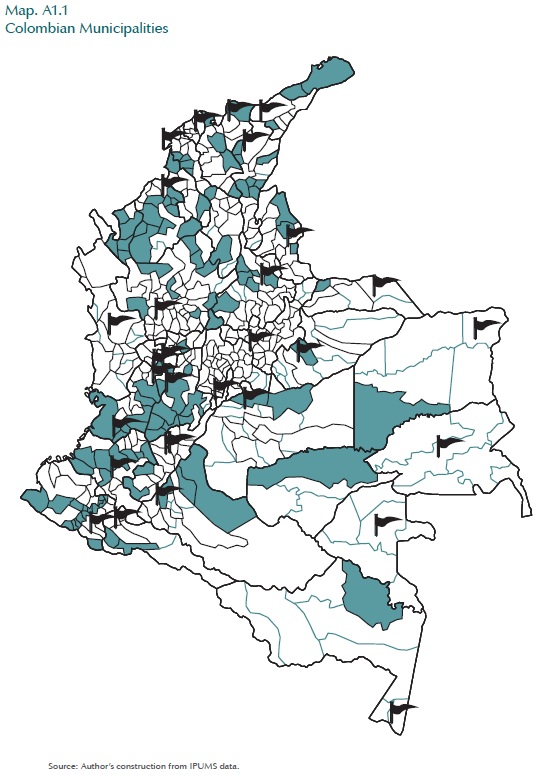
DATA CONSTRUCTION
INSTRUMENT: DEMOGRAPHIC STRUCTURE
Following Moretti (2004a), the instrument interacts two sources of variation that are exogenous to changes in local labor supply: the initial demographic structure in the municipality and the national trends in higher education in each demographic group. For each municipality m and age-gender group g at time t we calculate:

This is the share of population belonging to group g in municipality m at year t. There are 14 age-gender groups: 0-14, 15-24, 25-34, 35-44, 45-54, 55-64, 65-99, for males and females.
The instrument for the share of skilled workers in a given municipality can be estimated by using the lagged value of the municipal demographic structure and the national change in the share of skilled workers by education group.

Where g indicates age-gender group (e.g., male 15-24 years old), ΔPg,m− is the national change in college share for group g between two periods excluding the municipality itself (ΔPg,m− = Pg,m− ,t − Pg,m− ,t −1) and ωg,m,T is the share of group g in municipality m in a base period: 1973 and 1985. When the base years are used ωg, m is the proportion of people living in municipality m, who in 1993 (and 2005) would belong to the age group m. For example, a man who in 1973 (1985) is 10 years old is assigned to the group of males 25-34 in 1993 (2005). Moretti claims that using the age structure of a base year to predict changes in education has the advantage of independence of mobility patterns between 1973 (1985) and 1993 (2005) because if there was no mobility nor mortality ωg,m estimated with information on the base year would be on average equal to ωg,m that in 1993 and 2005.
It represents a measure of plausible exogenous variation derived by interacting cross-section differences in demographic composition with national changes in the shares of skilled workers. This instrument is exogenous if its both components are exogenous. The first component ωg,m,T is exogenous because it is measured in a base period. The second component, ΔPg,m−, shows the national variation in college share trends net of local dynamics, so it should be sufficiently exogenous to local supply dynamics. Intuitively, this instrument measures the local changes in the college share that one would have observed if the demographic structure had not changed since period t and if national trends in education affected all demographic groups with equal intensity. For example, if a specific demographic group g experienced a national increase in the share of educated workers of 10 percentage points, this instrument predicts that an equal increase will be observed in group g in any area, but those municipalities with an initial higher share of population in that group will experience a higher increase in their share of college students.
ADDITIONAL INSTRUMENTS
Several variables were employed to instrument the share of individuals with some college in combination with the variable described in the text (Moretti's instrument). By including additional exclusion restrictions we can not only test whether the results are robust but also it is known that adding over-identifying restrictions can lessen the rise in standard errors that accompanies moving from OLS to twostage least squares, and we can exploit such over-identification to test the validity of the instruments. The following table presents the results when three exclusion restrictions are included into the empirical analysis, and the last one includes a combination of them. In all cases, I control for all observable variables and for municipal and time fixed effects. Column (1) includes the population with some college to the working age population in 1973 and 1985 as an additional instrument for college share in 1993 and 2005. The reason to use this variable is that we expect, given the large time span, that lagged college share is not systematically correlated with municipal employment rates. Results clearly show that both exclusions restrictions are strongly correlated with college share since the Cragg and Donald Wald-F equals 32.2. Moreover, we cannot reject the hypothesis that the instruments are valid since the Hansen-test p-value is 0.47. Therefore, we can argue that our exclusion restrictions are non-weak and might be valid, so we can test whether the OLS and 2SLS estimates are statistically significant by estimating a Hausman test (robust to the presence of heterocedasticity). Results suggest that the difference is not significant. Column (2) uses the same variable but instead measuring over the working age population it uses the entire population (since working age population might be endogenous). Results are similar to those from the previous case. Column (3) includes the percentage of males and females that in 1973 and 1985 where between 45-54 and 55-64 years old and who had some college. The reason to include these variables is because these individuals will be out of the labor force in 1993 and 2005 and their influence into the labor market comes from the fact that they might induce younger individuals to enroll into higher education. Results confirm that the exclusion restrictions are not weak and valid. Once more, the difference between OLS and 2SLS is not statistically significant. Column (4) includes Moretti's instrument, the lag of the college share as a ratio of the total population, and the demographic structure of old individuals. These exclusion restrictions are strongly correlated with the college share, are valid, and suggest that there is a little difference between OLS and 2SLS estimates. In sum, for all the exclusion restrictions used we find robust results to those described in the main test. Moreover, the results presented here allowed to test the validity of the instruments and in all cases we could not reject the hypothesis that the instruments were valid. Finally, the difference between OLS and 2SLS estimates is never significant. These results give us more confidence to argue that OLS estimates described in the main text are consistently estimated.
TABLES
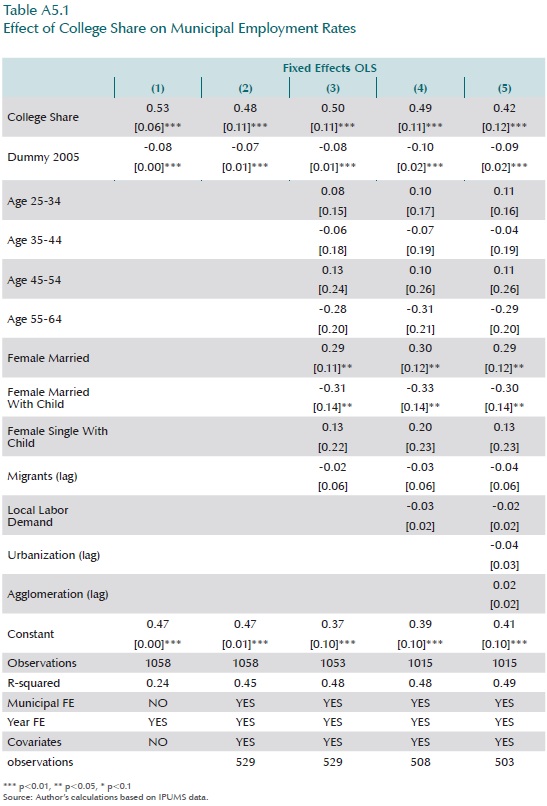
Table A5.2. Effect of College Share on Municipal Employment Rates - Instrumental Variables
